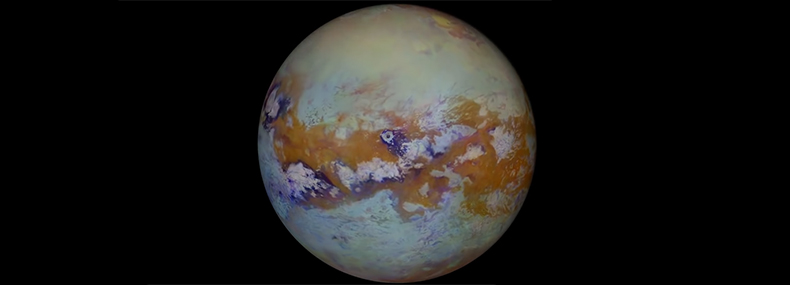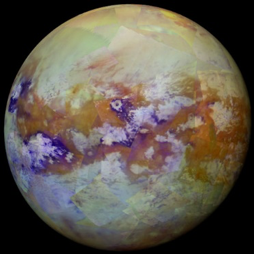First we had to sort and calibrate all the raw images precisely, then try to reduce the influence of the atmosphere, before obtaining these global maps of the surface at different wavelengths. By combining the observations, we can then highlight the geological diversity and reveal the main units in terms of composition, on a global scale. The band ratio technique, in which an image taken at one wavelength is divided by an image taken at another wavelength, has proved particularly effective in highlighting variations in composition.
In the synthetic video below, showing Titan’s surface in false colour, a large area appears in brown at the equator around the satellite. This zone corresponds to immense dune fields when compared locally with Cassini’s radar images (which only cover two-thirds of the surface). Other bluish regions appear on this new map, reflecting the presence of terrains of different composition, which can be explained by a local enrichment in water ice or organic compounds. The Sinlap and Menrva craters, shown in the video, are good examples. The integration of the entire VIMS dataset into a synthetic map enables a more detailed comparison with other observations, such as those from the Cassini probe’s radar, or with the images taken by the Huygens module during its landing, as can also be seen at the end of the video.
During the data analysis process, tools have been put in place to preview each individual spectral observation. Anyone can now easily access the beauty of Titan’s infrared images (and those of the other ice satellites) in just a few clicks using the https://vims.univ-nantes.fr website.
Cassini has revealed all the geological richness of Titan, the only body outside the Earth to have rain, rivers and seas, formed by hydrocarbons at 180°C, not water. Everything we have learned makes us want to go back with new means of investigation.
Ref : S. Le Mouélic, T. Cornet, S. Rodriguez , C. Sotin, B. Seignovert, J.W. Barnes, R. H. Brown, K. H. Baines, B. J. Buratti, R. N. Clark, P. D. Nicholson, J. Lasue, V. Pasek, J. M. Soderblom (2019) The Cassini VIMS archive of Titan: From browse products to global infrared color maps, Icarus, 319, doi:10.1016/j.icarus.2018.09.017 (arxiv.org/abs/1809.06545)









